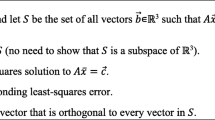Abstract
For business majors doing a survey course involving linear, integer, and possibly non-linear optimization, it is quite common to use the Solver in Excel for solving optimization models. In addition to this, or even indeed instead of doing this, we propose using optimization software which closely mimics the structure of the underlying algebraic model. For this, we suggest LINGO, not with the use of sets, but alternatively using only a basic set of commands, which is called scalar mode. We argue that this is simpler than using a solver add-in for Excel. Also, we argue that scalar mode in LINGO is much simpler than LINGO with the definition of sets, because the students do not have to learn and apply several concepts needed in order to apply the sets approach. We also give an example of when the transition to sets would be appropriate.
Similar content being viewed by others
Data Availability
Data sharing is not applicable to this article as no datasets were generated or analyzed during the current study.
Notes
This follows LINGO’s use of the term scalar to mean a model without set.
Solutions to these end-of-chapter problems may be obtained from the author at dtulett@mun.ca.
References
Powell SG (2001) Teaching modeling in management science. INFORMS Trans Educ 1(2):62–67
Hillier FS, Hillier MS (2007) Trends in OR and MS education at the introductory level. Tutorials in Operations Research, INFORMS
Pachamanova D (2006) Introducing integer modeling with Excel Solver. INFORMS Trans Educ 7(1):88–98
Troxell DS (2002) Optimization software pitfalls: Raising awareness in the classroom. INFORMS Trans Educ 2(2):40–46
Selvi RP, Sivasankari B, Vasanthi R (2020) Optimization using MS-Excel Solver. Biotica Research Today 2(10):1061–1062
Liberatore MJ, Nydick R (1999) The Teachers’ Forum: Breaking the Mold - A New Approach to Teaching the First MBA Course in Management Science. Interfaces 29(4):99–116
Savage S (1997) Weighing the PROS and CONS of decision technology in spreadsheets. OR/MS Today. 24(1):42–48
Savage S (1998)Insight.xla: business analysis software for Microsoft Excel. Duxbury Press, Brooks/Cole Publishing Company, Pacific Grove, California
Evans JR (2008) Teaching note: some practical issues with excel solver: lessons for students and instructors. INFORMS Trans Educ 8(2):89–95
LINDO Systems Inc. (2021) The Lindo story.https://www.lindo.com/index.php/company/the-lindo-story.Accessed 31 Sept 2021
Goodarzi E, Ziaei M, Hosseinipour EZ (2014)Optimization analysis using LINGO and MATLAB. In: Introduction to Optimization Analysis in Hydrosystem Engineering. Springer, Cham,pp 149–193
Krishnaraj C, Jayakumar AA, Shri SD (2015) Solving supply chain network optimization models using LINGO. Int J Appl Eng Res 10(19):14715–14718
Okafor BE, Nnanna I (2018) Optimization of Distribution Network of Nigerian Bottling Company PLC Using LINGO. University Of Technology Owerri, Imo State
Li M, Liu BY (2014) The optimization of typical environmental issues by LINGO software. Adv Mater Res 1010:1985–1988
Cunningham K, Schrage L (2004)The LINGO algebraic modeling language. In: KallrathJ (ed) Modeling Languages in Mathematical Optimization
LINDO Systems Inc. (2021). https://lindo.com/. Accessed 18 Feb 2022
Tulett DM (2022). Decision modeling, version 3.2.2. https://linney.mun.ca/?r=36808. Accessed 25 Nov 2022
Acknowledgements
The authors thank LINDO Systems Inc. for their constructive comments on this paper.
Funding
This research has been partially supported by Discovery Grants from the Natural Sciences and Engineering Research Council of Canada (grant #: RGPIN-2015-04013, RGPIN-2022-03514).
Author information
Authors and Affiliations
Corresponding author
Ethics declarations
Conflict of Interest
The authors declare no competing interests.
Additional information
Publisher’s Note
Springer Nature remains neutral with regard to jurisdictional claims in published maps and institutional affiliations.
This article is part of the Topical Collection on Model Development for the Operations Research Classroom.
Appendix
Appendix
This section gives the problem description that was used for the creation of the two-variable cement model [17].
A cement company makes two types of cement, which they market under registered tradenames, but for our purposes we will simply call them Type 1 and Type 2. Cement is sold by the Tonne (a Tonne is 1000 kilograms), and production is measured in Tonnes per Day, abbreviated as TPD. The company has contractual sales obligations to produce at least 40 TPD of Type 1 cement, and at least 30 TPD of Type 2 cement.
The physical capacity of the plant, which is governed by such things as conveyor belt speed, storage size, and so on, is limited to 200 TPD. A new labour agreement has increased the length of breaks, and restricts and makes more costly the use of overtime. The company therefore wishes to find its best production plan using the new work rules with everyone working a 40-h week. Work is measured in this company by the labour-hour, which is one person working for 1 h. Each type of cement is made in three departments, labeled A, B, and C. To make each Tonne of Type 1 cement requires three labour-hours in Department A, one and a half labour-hours in Department B, and four labour-hours in Department C. The amounts of work per Tonne of Type 2 cement are two, five, and six labour-hours in Departments A, B, and C respectively.
Based on the current authorized strength in each department, and factoring in allowances for breaks, absenteeism, and so on, Department A has 585 labour-hours available each day. Departments B and C are allowed to use up to 500 and 900 labour-hours per day respectively. These are the most they can use for the making of cement. If a department has some time leftover (i.e., if the time to make the cement is less than the number of labour-hours available), then the workers will be idle for a few minutes at the end of the day. The three departments require workers with very different training and skills, so the possibility of transferring employees from one department to another is not something that is factored into the planning process.
Taking the market price of each type of cement and from this subtracting all the variable costs of making the cement leaves the company with a profit of $8 per Tonne of Type 1 cement, and $10 per Tonne of Type 2 cement. There are also fixed costs (taxes, security, and so on) which total $1400 per day. The company wants to know how much should be produced of each type of cement, so that the profit is maximized.
Rights and permissions
Springer Nature or its licensor (e.g. a society or other partner) holds exclusive rights to this article under a publishing agreement with the author(s) or other rightsholder(s); author self-archiving of the accepted manuscript version of this article is solely governed by the terms of such publishing agreement and applicable law.
About this article
Cite this article
Tulett, D.M., Ke, G.Y. Using LINGO for Business Students. Oper. Res. Forum 4, 3 (2023). https://doi.org/10.1007/s43069-022-00184-2
Received:
Accepted:
Published:
DOI: https://doi.org/10.1007/s43069-022-00184-2




